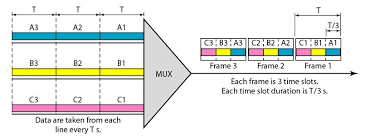
Splitting up the bandwidth

Frequency Division Multiple Access
image ©myreadingroom.co.in
Time Division Multiple Access
image ©myreadingroom.co.inThere is a limited amount of bandwidth available to the mobile phone operators which are split into channels. One of their requirements is to share their available channels between users. There are three basic methods of sharing the available frequency; using FDMA (Frequency Division Multiple Access), TDMA (Time Division multiple Access), and CDMA (Code Division Multiple Access).
Frequency Division Multiple Access The available bandwidth that comes in 5MHz blocks and is split into channels each separated from their neighbour. These separate channels allow for different users to access the bandwidth at the same time albeit with more limited (channel) bandwidth. This however can be wasteful in resources due to interference between adjoining channels. Thus space is made between the channels to stop the interference. However this simple FDMA can be improved by using OFDMA - Orthogonal Frequency Division Multiple Access. Also within a pure FDMA environment, and in the usual uneven spread of demand, one channel maybe busy whilst another is not well used. There is no ability to "share".
Time Division Multiple Access This is where the available time is split into time slots giving one user the whole of the spectrum, but for a limited time. After that the bandwith is given to the next user. This method of multiple access does allow sharing, the demand for the precious time on the channel is fairly shared between users. It does however rely on precise synchronisation of the use of the channel.
Time and Frequency Division Multiple Access Together The best use of the scare frequency resource is to mix FDMA and TDMA. The frequency / time space is split into block and these are allocated in a fair manner. Whilst this is a complex channel allocation, it does allow for an efficient use of the precious resource in a 'fair' way.
© mobilephonetechnology.co.uk all rights reserved 2017-2025
